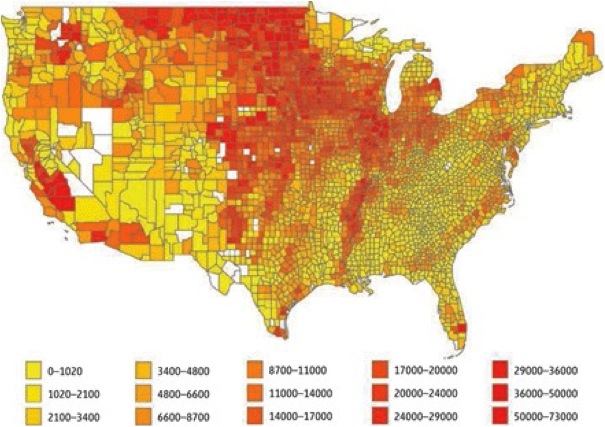U.S. agriculture could lose up to $53 billion because of "white-nose syndrome," a disease plaguing bats that has spread has spread to at least 16 states and three Canadian provinces in eastern North America, according to an article appearing in the journal Science and an interview with an Ohio State University expert.
|
WORTH OF INSECTIVOROUS BATS. Estimated annual value of insectivorous bats in the agricultural industry at the county level. Values (×$1000 per county) assume bats have an avoided-cost value of ∼$74/acre of cropland. (Souce: The journal Science). |
The total value of bats to U.S. agriculture — and the potential loss from white-nose syndrome — ranges from a low of $3.7 billion to a high of $53 billion a year, according to the study.
"Bats are among the most overlooked, yet economically important, nondomesticated animals in North America," the study's authors wrote, "and their conservation is important for the integrity of ecosystems and in the best interest of both national and international economies."
"Simply put, bats eat a lot of insects — insects that bother us around our homes, and insects that can damage crops and forests," said Ohio State University Extension wildlife specialist Marne Titchenell, who was not part of the study but gives bat conservation workshops around the state.
"It's logical to assume we'll lose a significant amount of the pest-control services that bats provide us as the disease spreads through Ohio and potentially the Midwest," Titchenell said.
The numbers, from an article called "Economic Importance of Bats in Agriculture" in the current issue of Science, are estimates based on crop acreage, the number of crop pests eaten by bats, the damage to crops that their feeding prevents, and the need, as a result, for farmers to spend less on pesticides.
"Because bats reproduce only once a year and most have only one or two offspring at a time, populations of bats infected by white-nose syndrome won't recover quickly," Titchenell said.
Caused by a newly identified fungus, Geomyces destructans, white-nose syndrome — so named for the white fuzzy growth it causes on bats' muzzles — was first detected in New York state in 2006, killed more than 1 million bats.
In all, the Science study said Ohio's agricultural losses to white-nose syndrome could range from $120 million in years with a low rate of insect pest survival — meaning there would be fewer pests to cause problems — to $740 million at a standard pest survival rate to $1.7 billion at a high rate.
But Titchenell cautions that the figures are only estimates extrapolated from cotton-dominated farmlands in Texas.
"This is the first study I know of to report (bats' agricultural) values by state and county," she said. "But until there's a similar study that extrapolates corn and soybean figures, we won't know for sure."
To read the full article in Science, click here.







Post a comment
Report Abusive Comment